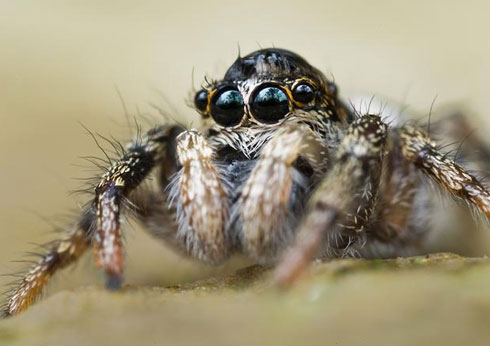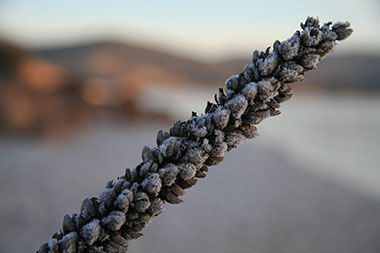Macro-Photography D-SLR Cameras
Macro/Close-up Photography
Close up photography, or macro photography as it's technically known, is a fascinating way of seeing your subject from a totally new viewpoint. By moving in closer you start to see new details that were just a blur of colours from a distance, and the world of nature, for one, takes on a whole new look.
Close up photography allows you to shoot things that you may not have previously thought possible, a close up of your diamond engagement ring, bees in the garden or flower stamens. You could also record your stamp collections for insurance purposes or home in on patterns and create textured backgrounds for your new web site, newsletter or project. The list of practical and creative applications is endless.The subject reproduced on the film or CCD is measured as a ratio of life size. For example, a camera that can record pictures at half life size means that the subject will appear recorded on the film or CCD half the size that it is in real life. This, of course, changes when an enlargement or print is made, as the subject then appears larger than life.
Come on inTo achieve macro photography your camera must have a focusing system that lets you produce sharp pictures from distances closer than
20cm, ideally closer. The latest digital cameras such as the Coolpix 995 and Ricoh i700 allow you to focus an amazing two centimetres from the subject, allowing you to fill the frame with a subject that's just 15mm wide. And because you can rotate the viewing screen you can shoot from low angles too. The subject appears on the LCD and an audible warning sounds so you can check focusing accuracy while an indicator on the Nikon shows when the zoom is set to the best point for the macro to function accurately. Needless to say, shooting macro photography is a doddle with this type of camera.
Most SLR manufacturers produce a range of lenses for their SLR cameras that also allow macro photography. The standard zoom lens supplied with an SLR camera will focus down to around one or one and a half metres, giving quarter life size (1:4) results, but the macro lens gives you half life size (1:2) or life size (1:1) with an extension tube.
Compact cameras have a macro setting that's usually indicated with an icon of a flower. This normally gets you to around 60cm from the subject, so true macro photography isn't an option, but they are usually adequate for taking photos of larger flowers and similar sized subjects.
There are a couple of special macro compact cameras made by Goko that have closer than normal focusing too.
Depth of fieldOne problem with macro photography is the limited amount of sharpness in front and behind the main point of focus. This is known as
depth-of-field and is very shallow at close range. This means you may, for example, get a really sharp flower stamen but the petals in front and behind will be disappointingly soft. You have several options. One method is to shoot from a distance and crop the photo later. This means you get a sharper overall subject, but the photo quality may not be as good because you have used either less pixels or less film, resulting in lower resolution or more grain. The more sensible option is to adjust the aperture, where available, selecting a smaller number which increase depth of field. Digital cameras often have a limited number of settings with f/8 usually being the limit.
SLRs go down to f/16, f/22 or f/32, depending on the lens. Both will help improve your chances. Reducing the aperture means less light is allowed to reach the film so the shutter speed has to be made longer to compensate. You are now faced with a dilemma because making the shutter speed longer increases the chances of camera shake. If the subject is static all you need to do is mount the camera on a tripod or rest it on a steady support such as a wall, pile of books, chair leg etc. If the subject is swaying in the wind you could create a wind shield, or alternatively use a faster film, add a spot of flash or try again on a wind free day.
If the subject is moving you should increase the film speed or take your chances using a wider aperture with less depth of field.
Some photographers purposely go for shallow depth of field allowing only one part of the image to be sharp. Flowers can look excellent when this technique is applied.
LightAnother problem you may encounter, especially when using a camera with extremely close focusing capability is that the camera is so close to the subject that it can cast a shadow. Try to move around to a suitable viewpoint allowing the light source to continue to illuminate the subject. Flash can be used but only with cameras that have off camera facility, so the flash can be positioned away from the camera in a suitable position allowing adequate subject illumination. SLR manufacturers provide a series of dedicated guns for their SLRs and digital cameras, including ring flash that gives more even coverage at short range.
Tips to help you improve your macro pictures-If your camera has a limited close focusing you could zoom out to the telephoto setting to increase magnification. Beware though depth of field is reduced further.
-If the camera has a filter thread attach a close up lens that screws into the front. These are available in +1, +2. +3 +4 and +10. Most cameras can be adapted with stepping rings or push on systems to allow a close up lens to be attached.
-You can mount a digital camera on the top of a magnifying loupe that you'd normally use to check transparency sharpness and use this to greatly improve the close focusing capabilities.
-Take a small white or silver reflector to throw light back towards the subject and fill in the shadows caused by overhead illumination.
-Increase the ISO speed of your digital camera manually to allow a faster shutter speed or smaller aperture. The results will have more noise (grain-like appearance) but they will be sharper with more depth of field.

Source:http://www.ephotozine.com/article/close-up-photography-4693































































